
Jackson station is a historic Amtrak station in Jackson, Michigan, United States. It is served by three daily Wolverine trains between Chicago and Pontiac and a single daily Amtrak Thruway bus between Toledo, Detroit, Jackson, and East Lansing. The station was added to the National Register of Historic Places in 2002.

Amboy station is a former rail station in the city of Amboy, Lee County, Illinois, United States. The building was constructed as a headquarters building for the Illinois Central Railroad as well as a public train station for the fledgling city of Amboy in 1876. It was designed by railroad staff architect James Nocquet after a fire destroyed the original Illinois Central offices on the site. The building was added to the U.S. National Register of Historic Places in 1992 as the Amboy Illinois Central Depot.

The Lena Water Tower is a water tower located in the village of Lena, Illinois, United States. It was built in 1896 following two decades of problems with structure fires in the village. The current water tower is the result of a second attempt after the first structure proved to be unstable. The tower stands 122.5 feet (37.3 m) tall and is built of limestone and red brick. The current stainless steel water tank holds 50,000 gallons and replaced the original wooden tank in 1984. The site has two other structures, an old power plant building and a 100,000 US gallon reservoir. The Lena Electric Plant Building was constructed in 1905 and the reservoir completed in 1907. The Lena Water Tower was listed on the U.S. National Register of Historic Places in 1997; the reservoir was included as a contributing property to the listing.

The Atchison, Topeka and Santa Fe Passenger and Freight Complex is a nationally recognized historic district located in Fort Madison, Iowa, United States. It was listed on the National Register of Historic Places in 1992. At the time of its nomination it contained three resources, all of which are contributing buildings. The buildings were constructed over a 24-year time period, and reflect the styles that were popular when they were built. The facility currently houses a local history museum, and after renovations a portion of it was converted back to a passenger train depot for Amtrak, which opened on December 15, 2021.

St. Mary's Catholic Church is a parish church of the Diocese of Davenport. The church is located at the corner of St. Mary's and Washburn Streets in the town of Riverside, Iowa, United States. The entire parish complex forms an historic district listed on the National Register of Historic Places as St. Mary's Parish Church Buildings. The designation includes the church building, rectory, the former church, and former school building. The former convent, which was included in the historical designation, is no longer in existence.

Hillside, also known as the Charles Schuler House, is a mansion overlooking the Mississippi River on the east side of Davenport, Iowa, United States. It has been individually listed on the National Register of Historic Places since 1982, and on the Davenport Register of Historic Properties since 1992. In 1984 it was included as a contributing property in the Prospect Park Historic District.

The Adair County Courthouse, located in Greenfield, Iowa, United States, was built from 1891 to 1892. It was individually listed on the National Register of Historic Places in 1981 as a part of the County Courthouses in Iowa Thematic Resource. In 2014 it was included as a contributing property in the Greenfield Public Square Historic District. The courthouse is the third structure to house county courts and administration offices.

City Hotel, also known as Seifert's Tavern and the Wheatland Feed Mill, on 214 South Main Street in Wheatland, Iowa was listed on the National Register of Historic Places for Clinton County, Iowa in 2007.

The Bloomington freight station is a historic train station in downtown Bloomington, Indiana, United States. Constructed in the early twentieth century, it has endured closure and a series of modifications to survive to the present day, and it has been declared a historic site. Used only occasionally for many years, it is one of the most important buildings in a large historic district on the city's west side.

The St. Joseph's Church Complex is a collection of historic buildings located in Fort Madison, Iowa, United States. At one time the complex housed a Catholic parish in the Diocese of Davenport. St. Joseph and St. Mary of the Assumption parishes merged in the 1990s to form Saints Mary and Joseph Parish. In 2007 when that parish merged with Sacred Heart on the west side to form Holy Family Parish, St. Joseph's Church was closed. The former church, chapel, rectory, convent, and school were included as contributing properties in the Park-to-Park Residential Historic District that was listed on the National Register of Historic Places in 2014.

The Pierceton Historic District encompasses the central business district of a small community in east central Kosciusko County, Indiana. It is next to the former Pennsylvania Railroad line. The design, setting, materials, workmanship and association between buildings give a sense of the history and architecture of a small town main street.

Keokuk Union Depot is an historic train station on the west bank of the Mississippi River near downtown Keokuk, Iowa, United States. It was built from 1890 to 1891, and it was listed on the National Register of Historic Places in 2013.
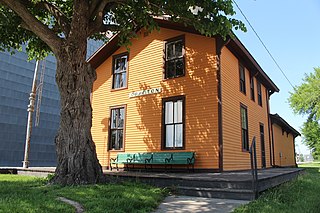
The Chicago, Milwaukee, and St. Paul Railroad-Grafton Station, also known as Grafton Depot, is a historic structure located in Grafton, Iowa, United States. The town of Grafton was surveyed and platted by the Chicago, Milwaukee and St. Paul Railroad in 1878, and the depot was completed by the railroad the following year. The railroad was important to the economic life of the town as it was the main source for receiving consumer goods and selling agricultural products, which was the area's primary industry. The depot closed in October 1974, one of the last small town depots to close in Iowa. It was listed on the National Register of Historic Places in 1976. The former depot was refurbished and it now houses a local history museum.

The Iowan's Hotel, now known as the Railroad Inn, is a historic building located in Essex, Iowa, United States. The town of Essex was established by the Burlington and Missouri River Railroad. It was platted in 1870 as a station along the line. The depot opened in 1871 and the Lindel Hotel was completed in 1878. This building was completed in 1906 to replace the outdated Lindel. It operated under a variety of names over the years, including the Essex Hotel, Rose Hotel, Commercial Hotel, Bradley Hotel, Butler Hotel, Essex House, and the Railroad Inn. It is operated as a bed and breakfast under the last name. The building was listed on the National Register of Historic Places in 2009.
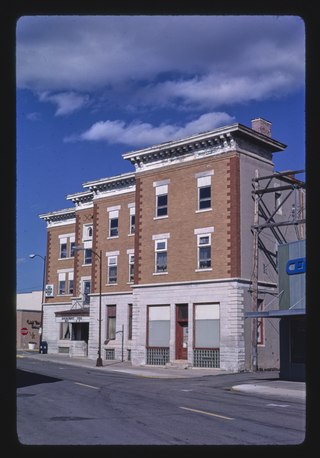
The Lewis Hotel is a historic building located in Cherokee, Iowa, United States. Robert A. Lewis was a New York City native who settled in the Cherokee area in 1872. He had a background in carpentry, but he established a nursery in Cherokee. After moving into town he started planning for his hotel around 1897. He served as the contractor for its construction, and it was completed two years later. The hotel remained in the care of his family until 1966.
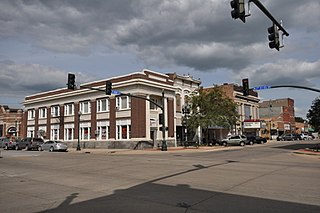
The Cherokee Commercial Historic District is a nationally recognized historic district located in Cherokee, Iowa, United States. It was listed on the National Register of Historic Places in 2005. At the time of its nomination it contained 70 resources, which included 50 contributing buildings and 20 non-contributing buildings. The historic district covers most of the city's central business district. Most of the buildings are two and three stories tall, and built of brick. There are two frame buildings from the city's earliest years. Cherokee is somewhat unusual in that it did not have a devastating fire in its history, therefore the downtown area was able to grow incrementally. Unlike many county seats, it does not have a focal point such as a centrally located courthouse square. The Cherokee County Courthouse was built on a hill to the west of the downtown area.

Illinois Central Passenger Depot-Storm Lake, also known as the Storm Lake Depot, was an historic building located in Storm Lake, Iowa, United States. The Iowa Falls & Sioux City Railroad, an Illinois Central Railroad (IC) subsidiary, built the first tracks through town in 1870. They also built a two-story frame combination freight and passenger depot the same year. The present depot is a second generation IC structure built of brick. The building's architectural style is Prairie School with Tudor Revival elements in the dormer and canopy ends. It was designed by IC architect E.E. Bihl, and it is similar to the railroad's depots in Flossmoor, Illinois and Fort Dodge, Iowa. The new passenger depot was completed in August, 1915, and the old depot was re-purposed for a dedicated freight depot. It was torn down sometime before 1948. Passenger service remained high during the 1910s and 1920s, with the decline accelerating after World War II, and it ended all together in the late 1960s. While freight trains continue to use the IC's tracks, the depot has been abandoned. It was listed on the National Register of Historic Places in 1990. The Storm Lake Illinois Central depot was demolished on February 25, 2013.

Onawa Public Library is located in Onawa, Iowa, United States. The public library began in 1902 when Judge Addison Oliver offered to buy the former Congregational Church for a library building, and funds to buy books and fixtures. His offer was accepted by the community, which also promised to maintain the facility as a free library. The library soon outgrew the old church and in November 1906 the board of directors approached the Carnegie Corporation of New York for a grant to build a library building. A $10,000 grant was approved on December 13, 1907. Judge Oliver donated another $10,000 for the building, and an additional $10,000 for an endowment fund. The Chicago architectural firm of Patton & Miller designed the Prairie School building, which was dedicated on October 22, 1909. It was listed on the National Register of Historic Places in 1979.
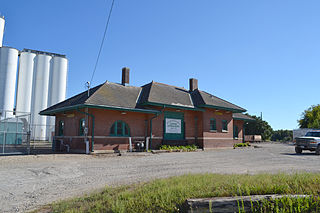
Iowa Falls Union Depot is a historic building located in Iowa Falls, Iowa, United States. The Dubuque & Sioux City Railroad, an affiliate of the Illinois Central Railroad (IC), laid the first rail track to Iowa Falls in 1866. The following year the Iowa Falls & Sioux City Railroad, another IC affiliate, continued construction of the line to the west, and it reached Sioux City by 1870. They built a plain, two-story frame depot to serve Iowa Falls. The Burlington, Cedar Rapids and Northern Railway (BCR&N) by way of its affiliate the Cedar Rapids, Iowa Falls & North Western, entered Iowa Falls in 1880. They built their own depot. It was basically another east–west route, but local business leaders desired a north–south route to serve the community.
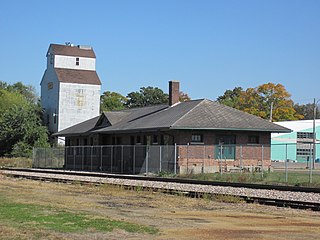
Illinois Central Combination Depot-Ackley is a historic building located in Ackley, Iowa, United States. The Dubuque & Sioux City Railroad, an affiliate of the Illinois Central Railroad (IC), laid the first rail track to Iowa Falls in 1865. Two years later the Iowa Falls & Sioux City Railroad, another IC affiliate, continued construction of the line to the west, and it reached Sioux City by 1870. They built a plain, two-story frame depot to serve Ackley. From the 1890s to the 1920s the IC replaced its first generation stations with new brick structures. IC architect J.H. Schott designed the new depot at Ackley, and it was built by Coomer & Small Construction Company of Sioux City. The long and low single-story brick building exhibits influences from the Prairie School and the Tudor Revival style. A combination depot is one that incorporates passenger and freight services in the same building. It was also an island depot, meaning that it sat in the middle of the tracks. It was one of the last replacement depots the IC built before the Great Depression. The building was listed on the National Register of Historic Places in 1990.























